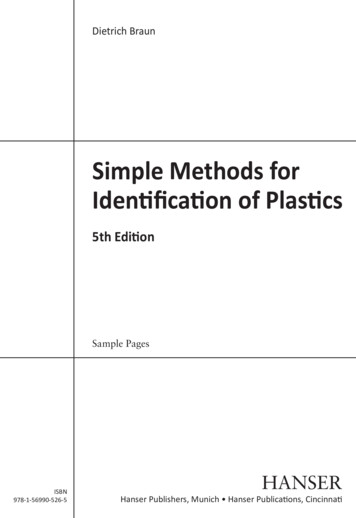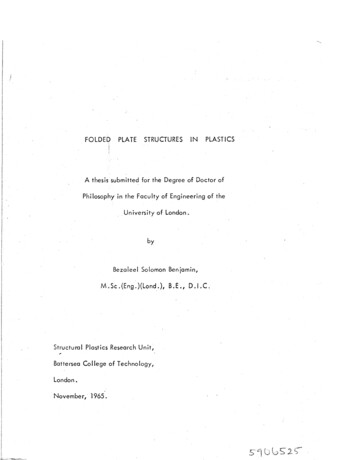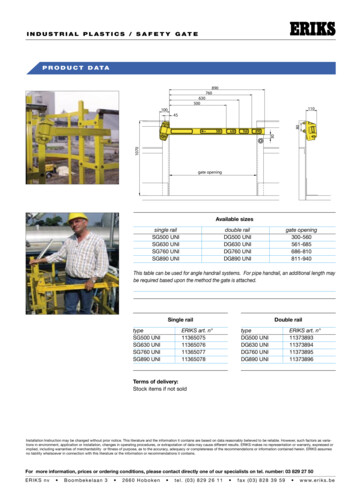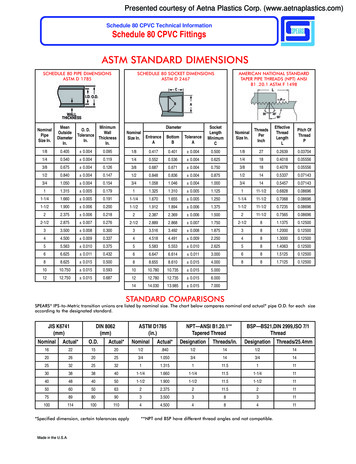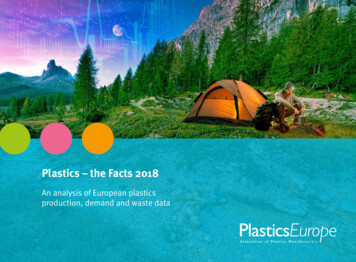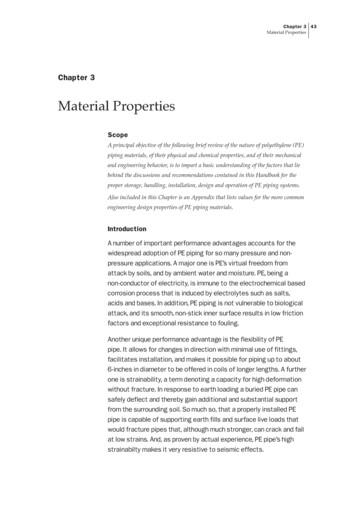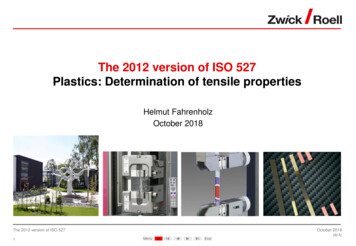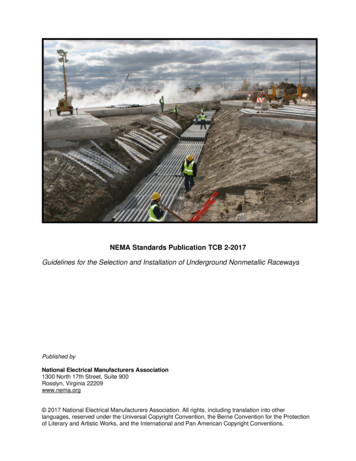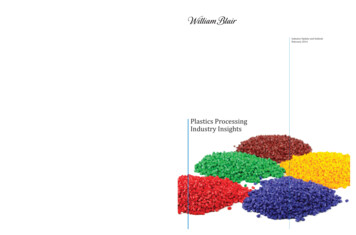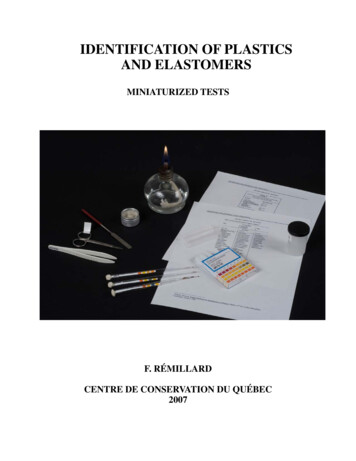
Transcription
IDENTIFICATION OF PLASTICSAND ELASTOMERSMINIATURIZED TESTSF. RÉMILLARDCENTRE DE CONSERVATION DU QUÉBEC2007
TABLE DES MATIÈRESIntroduction . 3BEILSTEIN TEST . 8DIPHENYLAMINE TEST. 10LEAD ACETATE TEST. 12HYDROXYLAMINE HYDROCHLORIDE TEST. 14FORMALDEHYDE TEST. 16MOLISCH’S TEST . 17MOLISCH’S TEST . 18DIMETHYLAMINOBENZALDEHYDE TEST . 20APPENDICES . 22Table 1 pH Values of Vapours Released from Sheet Materials During Heating . 23Table 2 Litmus and pH Tests for Combustion Vapors of Plastics . 23Table 3 Specific Gravity of Selected Plastics . 24Table 4 Specific Gravities of Selected Plastics in Relation to Standard SaturatedSolutions . 25Table 5 Approximate densities of important plastics . 26
Centre de conservation du QuébecIdentification of plastics and elastomersINTRODUCTIONThe tests to identify plastics and elastomers described in this document are all drawn from thescientific literature. Our work thus consisted of miniaturizing them.Conservators are often called upon to characterized a material in order to understand or anticipateits behavior over time, select a treatment, or authenticate or date museum objects. Since theseobjects are unique, precious, and irreplaceable, the sampling methods must be as uninvasive aspossible. They must also be easy to use not require sophisticated equipment use inexpensive, readily obtainable products and provide reliable, reproducible results.Some of our miniaturized tests are based on a wipe method using microscope slides and others, on apyrolysis method using Pasteur pipettes.Wipe MethodFor the wipe method,samples are collected bygently rubbing the surfaceof the object over thefrosted end of a microscopeslide.Samples are collected by gently rubbing the frosted endof a microscope slide over the surface of the object. Theappropriate reagent is then deposited on the sample, onthe slide. The development of a distinctive color is anindication of the composition of the sample. Microscopeslides, which are widely used in laboratories, areinexpensive. This technique removes such a smallamount of sample that it cannot be seen with the nakedeye and can be barely detected using a binocularmicroscope.The appropriate reagent is then deposited on the traceleft, on the slide, by the rubbing of the sample.3
Centre de conservation du QuébecIdentification of plastics and elastomersPyrolysis MethodBurning samples in a Pasteur pipette is a very effective technique in several respects. Likemicroscope slides, pipettes are widely used in laboratories and are inexpensive. The capillary end ofPasteur pipettes can be rapidly flame-sealed. The wide mouth of the tubular end of the pipetteThe capillary end of Pasteur pipettes can be rapidly flamesealed.The tubular end of the pipette makes a useful funnel to collectthe sample and push towards the capillary end.makes it easy to insert the sample in the pipette, which falls into the sealed capillary end. Indicatorstrips or cotton swabs impregnated with reagent can also be inserted in the tubular end of thepipette. Once the sample and indicators have been placed in the pipette, the tubular end is sealedwith modeling dough such as Plasticine. When the sample in the capillary end of the pipette isheated using the alcohol burner, its behavior (sublimation, melting, decomposition) as well as anycharacteristic combustion vapors (color) can be readily observed. If the sample softens and melts, itis may be a thermoplastic since thermosetting resins tend to keep their shape until they reach theircombustion temperature. In addition, since the combustion vapors are trapped inside the pipette,they can react with the indicator strips or thecotton swabs impregnated with reagent. Theresults can be read within seconds or, at the most,minutes. After this step, the Plasticine stoppercan be removed, releasing the combustion vapor.Even very small samples release easily detectableodors that can be identified by the “nose test,”which can be repeated as long and as often asrequired, which is not the case with samplesvaporized in an open flame.Once the sample and indicators have been placedin the pipette, the tubular end is sealed withmodeling dough such as Plasticine. Then thesample in the capillary end of the pipette is heatedusing the alcohol burner, to free the combustionvapours.4
Centre de conservation du QuébecIdentification of plastics and elastomerspH and Specific GravityThe pH of the combustion vapor is a useful way of identifying plastics. A pH indicator strip isinserted in the tubular end of the pipette. We have obtained good results with Merck ColorPhast pHstrips. Since the strips are slightly too wide, they are cut lengthwise. The strips are bent so that theyare held in place by simple pressure against the wall of the pipette. Before inserting them in thepipette, the strips must be wetted. The tubular end of the pipette is then sealed with modelingdough. The sample in the capillary end of the pipette is then heated. Since the combustion vapor isheavier than air, the pipette is laid flat on the work surface for a few seconds or minutes, dependingon the size of the sample, so that the vapor can come into contact with the pH strip. The color of thestrip in the pipette is then compared to the pH reference scale provided with the strips. Refer totables 1 and 2 (Appendices) for the pH values of the combustion vapors of most common plastics.Merck ColorPhast pH strips are slightly toowide, they are cut lengthwise. The strips arebent so that they are held in place by simplepressure against the wall of the pipette.The strips are bent so that they are held inplace by simple pressure against the wall of thepipette. The tubular end of the pipette is thensealed with modeling dough (Plasticine). Thesample can then be brought to the flame.The pH indicator strips must be wetted beforeuse.The sample is brought to the flame to free thevapours of combustion that will influence theindicators present in the pipette. Since thecombustion vapours are heavier than air, thepipette is laid flat on the work surface for a fewseconds or minutes, depending on the size ofthe sample, so that the vapour can come intocontact with the pH strip.5
Centre de conservation du QuébecIdentification of plastics and elastomersThe specific gravity of samples can be measured before vaporizing them by placing them insaturated salt solutions (see appendices for specific gravity reference tables and recipes for the saltsolutions). A very small sample collected on the object can be floated in different solutions. It willfloat where it is less dense and it will sink when it is denser than the solution. All the polyolefins(polyethylene and polypropylene) will float in water. The presence of fillers in the resin will alterthe specific gravity of the sample but this is taken into account in the reference tables. Plastictransformed into foam cannot be tested for specific gravity. The results of these two tests can becombined with those of the solubility test, another tried and true method. Conservators are generallyable to identify, or at least characterize, a material based on the results of these tests.The color of the strip in the pipetteis then compared to the pHreference scale provided with thestrips. Here, front top to bottom :pH 4.0, pH 6.0 and pH 9.0 (readingon the back of the box).Refer to tables 3,4 and 5 (Appendices) for the pH values of thecombustion vapours of most common plastics.A very small sample collected on the object can be floated in different solutions.It will float where it is less dense and it will sink when it is denser than thesolution. The specific gravity of samples can be measured by referring tospecific gravity reference tables.6
Centre de conservation du QuébecIdentification of plastics and elastomersReference plastics are required as controls They are also used to master the technique and to ensurethat the reagents are still effective, or still useable, or not outdated. Each test sample should be runwith a reference sample.ConclusionReference plastics are required as controls They are also used to master the technique andto ensure that the reagents are still effective, or still useable, or not outdated. Each testsample should be run with a reference sample.Identifying plastics and elastomers is often complicated by the nature of the materials, which maybe copolymers or mixtures of different polymers, or may contain fillers, plasticizers, stabilizers,colorants, etc. While these miniaturized tests cannot identify all plastics, they are simple, effective,and ideally suited to confirm the identity of many plastics and elastomers. This document describesthe applications, required materials, protocols, interpretation, safety recommendations, andreferences for 7 miniaturized tests. The sources and prices of many of the materials are alsoprovided.The size of a sample to be submitted to a pyrolysis test can be so small, that itbecomes hardly visible to the naked eye. Here, enlarged to enhance visualization.7
Centre de conservation du QuébecIdentification of plastics and elastomersBEILSTEIN TESTApplicationThis is a pyrolysis test that is used to detect chlorine in vinyls (polyvinyl chloride [PVC] andpolyvinylidene chloride [PVDC]), hydro chlorinated rubbers, and chloroprene rubber-basedadhesives such as contact cement.Materials RequiredSpool of small gauge copper wireSmall piece of balsaAlcohol burnerProcedureThe copper wire must be completely clean and free of any contamination. A fresh piece of wireshould be used for each test. Cut a strand of small gauge copper wire is cut from the spool. Insertone end of the wire in a piece of balsa. Heat the other end in the flame of the alcohol burner until itbecomes red hot. Touch the red-hot end of the copper wire to the sample and then place it back inthe flame. A distinctive blue/blue-green color indicates a positive test, i.e., the presence of chlorine.InterpretationThis test can also be used to identify thermoplastics, which melt when touched with the red-hotcopper wire, while thermosetting resins do not. Even if the test is negative for the presence ofchlorine, it provides other useful information on the type of plastic. Hydro chlorinated rubbers maybe confused with vulcanized rubber because they are similar in appearance, but they will give anegative result in the lead acetate test (see Lead Acetate Test). Certain rubber-like PVCs may beconfused with rubber hydrochlorides. When in doubt, a carbon tetrachloride solubility test can beperformed—rubber hydrochlorides are soluble in carbon tetrachloride while PVCs are not. TheBeilstein test cannot be used for mineral chlorides. In addition, certain flame-retardants can producefalse positives. When in doubt, measure the pH of the combustion vapor in the pipette—PVC vaporis very acid (pH 1; see tables 1 and 2 in the appendices for the pH values of combustion vapors).RecommendationsTest the procedure on a reference sample first. Since the test burns the surface of the test material,use a small gauge wire and select the zone to be analyzed carefully to minimize damage to theobject. If the same wire is used for subsequent tests, cut off the heated end of the wire beforeperformed the subsequent test to avoid cross-contamination.8
Centre de conservation du QuébecIdentification of plastics and elastomersReferenceCCI Notes, Canadian Conservation Institute, Note 17/1Cut a strand of small gauge copper wire from the spool. Insert one end of the wire in a piece ofbalsa to avoid burns to the fingers. Heat the other end of the wire in the flame of the alcohol burneruntil it becomes red hot. Lightly touch the surface of the material to be analyzed with the wire andreturn it to the flame. A bright green flame indicates the presence of chlorine ion.9
Centre de conservation du QuébecIdentification of plastics and elastomersDIPHENYLAMINE TESTApplicationThis wipe test is used to detect nitrogen oxides in cellulose nitrates (celluloid, Xylonite,Parkesine). This result is obtained by the wipe method.Materials RequiredMicroscope slides with frosted end0.5% (w/v) diphenylamine in 70% sulfuric acid (70 parts acid in 16 parts water)Disposable droppers or capillary tubesDiphenylamine, free base, purified (Sigma-Aldrich, D2385, 20.00/5 g)ProcedureGently rub the frosted end of themicroscope slide against the surface ofthe object. Add a drop of reagent andspread it across the frosted end of themicroscope slide. An intense blue colorindicates a positive test.Sample is collected by gently rubbingthe surface of the object over thefrosted end of a microscope slide.InterpretationSince this test is very sensitive, surface contamination may occasionally result in a false positive.Clean slides must thus be used for eachsample. When in doubt, performMo
Centre de conservation du Québec Identification of plastics and elastomers 5 pH and Specific Gravity The pH of the combustion vapor is a useful way of identifying plastics. A pH indicator strip is inserted in the tubular end of the pipette. We have obtained good results with Merck ColorPhast pH strips. Since the strips are slightly too wide, they are cut lengthwise. The strips are bent so that they
